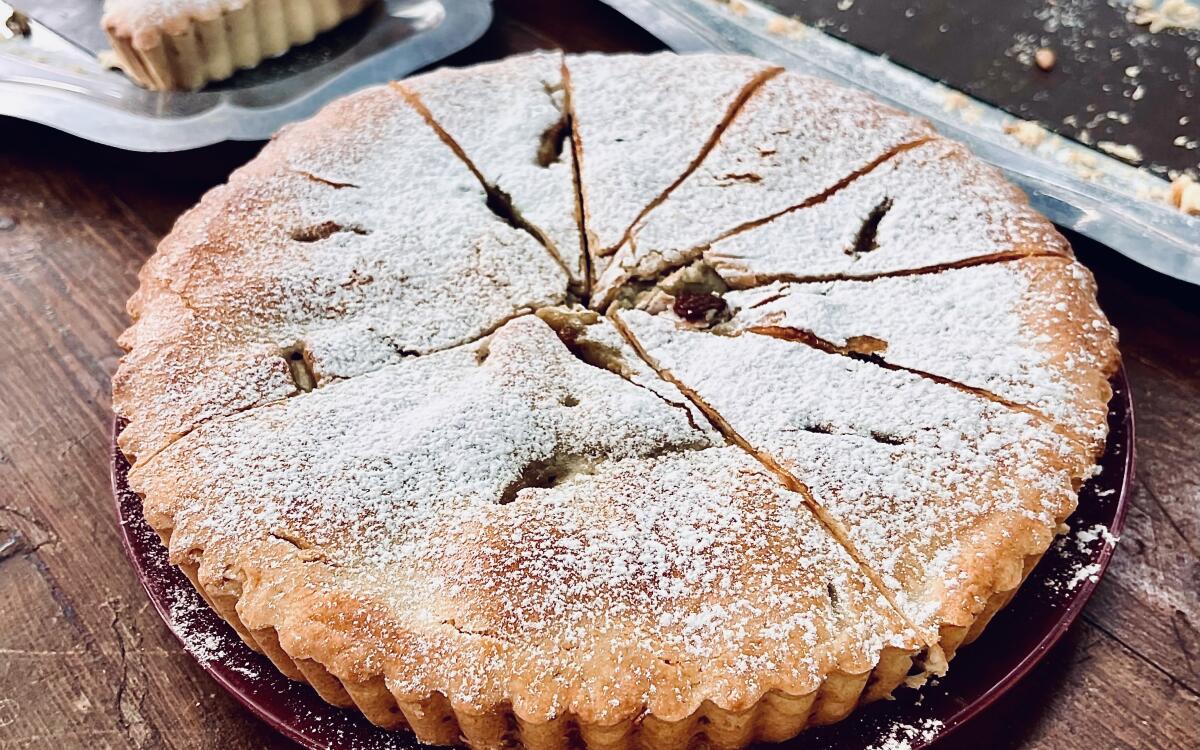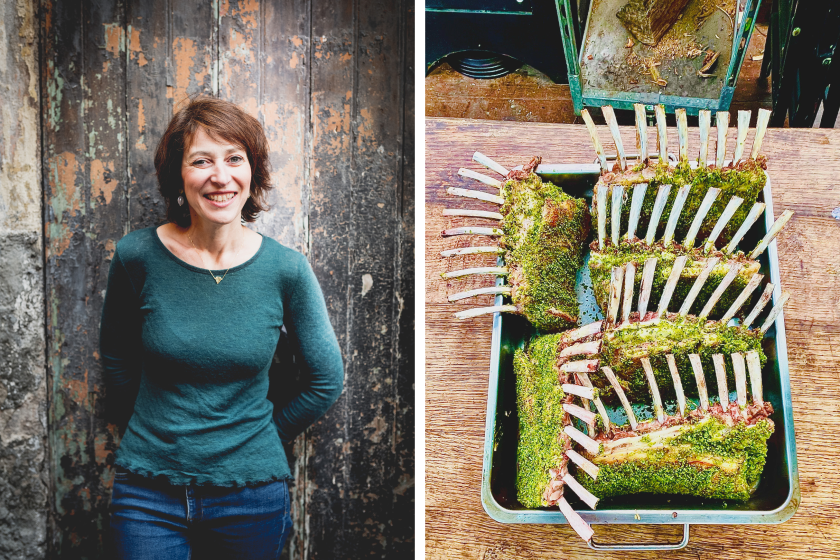Tourte De Blettes Sucrée (Sweet Swiss Chard Pie)

- Share via
When I first moved to Nice, France, I lived upstairs from the now-defunct bakery Espuno, which had been run by the same family for generations. This bakery had none of the elaborate pastries I had grown used to seeing in Paris; instead, next to the croissants and brioches, it showcased square slabs of pie with a dark green filling, the top crust sprinkled with a thick coating of sugar.
This was my first exposure to tourte de blettes sucrée, the iconic Niçoise dessert that is sold in most local bakeries and is, for many children, including my son, a primary source of greens in their diet. Filled with a sweetened mixture of Swiss chard, rum-soaked raisins, pine nuts, apple, and perhaps grated Parmesan or Sbrinz (an aged Swiss cheese), this dessert does not appear anywhere else in France, although Tuscan cooks make a similar pie using vin santo instead of rum.
It was born of an abundance of Swiss chard; in winter, when local fruit was scarce, cooks used what they had available to satisfy a sweet craving. The coating of sugar — originally granulated, but now almost always powdered — distinguishes it from the savory tourte de blettes salée, which is filled with a mixture of Swiss chard, rice, bacon, Parmesan and egg.
There are as many variations on this dessert as there are families in Nice, but I like this one adapted from a recipe by Hélène Barale, who once ran a famous Niçoise restaurant named after her. Her use of apricot jam adds another fruity element besides the apple, without oversweetening the pie.
If you’re serving this to children, don’t worry about the rum — the alcohol cooks off in the oven. The quality of the rum does make a difference in the final taste of the pie, though, so use one that you would happily drink. And soak the raisins overnight if you can.
There’s a certain reverse snobbery that some travelers may feel when they first arrive in Nice.
For the pastry: Place the flour, confectioners’ sugar, baking powder and salt in the bowl of a stand mixer fitted with the paddle attachment and mix for a few seconds on low speed. (Or combine in the bowl of a food processor and pulse for a few seconds.) Add the butter and mix (or pulse) until fine crumbs form. Add the egg, 2 tablespoons milk, the rum and lemon zest and mix on low speed (or pulse) until you have a soft dough. If the dough does not come together, add another 1 to 2 tablespoons milk.
Turn the dough out and knead lightly by hand for about 20 seconds, then divide it into 2 pieces, one twice as large as the other one. Flatten them into disks about 1 inch (2.5 cm) thick. Wrap each piece in plastic wrap and refrigerate for at least 30 minutes, and up to 24 hours.
For the filling: Soak golden raisins in rum overnight if possible, or at least 1 hour. Toast the pine nuts in a small frying pan over medium heat; remove from the heat and set aside.
Bring a large pot of water to a boil. Add the chard leaves, bring back to a boil, and cook for 1 minute. Drain in a colander and rinse the leaves well under cold water. Squeeze out the leaves with your hands, one half at a time — you should end up with two baseball-sized balls of chard.
Finely chop the chard (do not use a food processor for this, which would turn the chard into a puree).
In a large bowl, combine the chard, the raisins and their soaking liquid, the toasted pine nuts, apricot jam, Parmesan or Sbrinz, if using, and sugar. Add the egg and mix well.
Assemble and bake the tart: Preheat the oven to 400°F (200°C). If you let the dough rest for longer than 2 hours, knead it again for 20 to 30 seconds, adding a little flour if it feels sticky, before rolling it out — otherwise, it may easily tear.
On a floured surface, roll out the larger disk of pastry to an 11-inch (28 cm) round about ⅛ inch (3 mm) thick, using as much flour as you need so that it doesn’t stick. Fit it into a 9-inch (23 cm) tart pan, pressing it against the bottom and up the sides, letting the excess dough hang over the sides.
Spread the chard mixture evenly over the pastry, then top with the apple slices, if using, arranged in a spiral.
Roll out the second piece of pastry to a 10-inch (25 cm) round and place on top of the filling. Pinch the edges of the dough together, then trim the edges with scissors to ½ inch (1 cm) wider than the pan and crimp all the way around. Make a few slits in the top crust using scissors or a small knife, or prick in a few places with a fork. Brush the top of the tart with the egg wash, if using.
Bake the tart for about 35 minutes, until well browned on top. Cool on a rack.
Sprinkle the top of the tart generously with confectioners’ sugar before serving. (Store any leftovers in the refrigerator for up to 3 days.)
Eat your way across L.A.
Get our weekly Tasting Notes newsletter for reviews, news and more.
You may occasionally receive promotional content from the Los Angeles Times.










